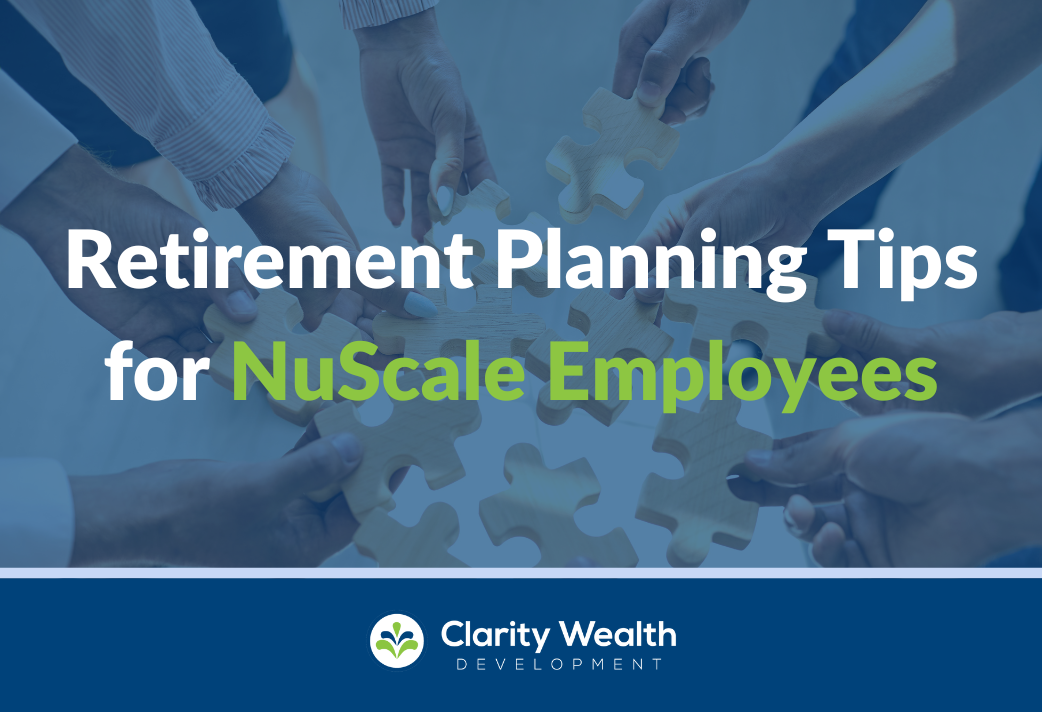Creating a retirement plan is like making a pizza. You need dough, cheese, sauce and toppings, but you can use a variety of ingredients to create each element. There are millions of ways to make a pizza, but they all have the same goal of creating a delicious meal.
In the same way, a retirement plan is built with a variety of factors, but they all work together toward the same goal of taking care of you and your loved ones in retirement.
As a NuScale employee, you have access to some great financial tools for saving toward retirement. In today’s blog, I want to walk through a few of the most important and help you understand how to use them to protect your future.
Understanding NuScale’s 401(k)
NuScale’s 401(k) match is a great benefit for you as an employee. NuScale matches 100% of the first 3% of your pay that you contribute and 50% of the next 2%.
Let’s look at an example of Bob, a NuScale employee that I just made up who earns $100,000 a year. Bob wants to take advantage of NuScale’s matching program, so he contributes 3% of his income, which comes to $3,000. NuScale matches 100% of that first 3%, so he’s up to $6,000 a year. After that, he contributes another 2% ($2,000), and NuScale matches 50% of that ($1,000).
All in, Bob is putting $9,000 a year in his 401(k), but it’s only costing him $5,000 of his own money.
For what it’s worth, my advice is to maximize your contributions here before contributing anywhere else. Free money is free money.
And you can contribute more to your 401(k) than just that 5%. Just because NuScale doesn’t match it doesn’t mean you should stop there. You can contribute a maximum of $22,500 to your 401(k) in 2023.
The great thing about 401(k)s is that all of the contributions you add reduce your taxable income, which directly reduces the amount of taxes you pay.
For example, if someone with a taxable income of $210,000 is in the 32% tax bracket, making a $10,000 401(k) contribution will reduce their taxable income to $200,000 and in turn, reduces their taxes by $3,200.
Speaking of taxes, one thing to keep in mind is that your 401(k) is built with pre-tax dollars, meaning that the money in it will be taxed when you withdraw it later in life. This can be a bit of a rude awakening if you’re not prepared for it.
How can you prepare? By building a little tax diversity into your portfolio with equity compensation such as RSUs and NQSOs, which are a critical part of your ongoing retirement benefits within NuScale. Ideally, the equity compensation will help you start building your taxable investment account outside of retirement.
This account is especially helpful if you are eyeing an early retirement or plan on taking extended time off employment in the future. Taxable accounts have no early withdrawal penalties, no contribution limits, and preferred tax treatment.
Looking for a financial advisor? Here’s an article you might find interesting: 3 Actual Quotes from Real Clients on Why They Chose Clarity Wealth Development
Investing as a NuScale Employee
Investments are the backbone of your retirement, so it’s important to get the strategy right based on your retirement timeline, risk tolerance and goals.
Younger investors should typically take a little more risk (more equities and less fixed income) because of their long time horizon until retirement. On the other hand, people closing in on retirement within the next few years should play it a little safer (fewer equities and more fixed income) since they will need to pull from their investments after retirement for living expenses.
Target date funds are typically a great option as they are built to become more conservative as you get closer to retirement.
Risk Management
Beyond insurance, it’s important to address the investment risk associated with working at NuScale. A significant portion of your financial security, including your paycheck and retirement savings, may be tied to the success of NuScale. This concentration of risk can be concerning.
One way to mitigate this risk is to diversify your investment portfolio. Diversification involves spreading your investments across different asset classes and industries, reducing your exposure to the performance of a single company or sector.
By doing so, you can better protect your financial future and ensure that your family’s well-being isn’t solely dependent on the success of NuScale. One practical way of doing this is to keep your NuScale stock to less than 5% of your overall investment portfolio.
Pay Down Bad Debt
Beyond your NuScale benefits and investments, one of the best ways to prepare for retirement is to get clear of any unhealthy debt.
Prioritizing the repayment of high-interest debts, such as credit card debts or high-interest car loans, should be a primary financial objective. Resolving these obligations can free up additional funds for retirement contributions and investments and move you closer to your financial goals.
For instance, focusing on paying off a high-interest car loan might be a wiser choice than maximizing your 401(k) contributions for now. This might be painful for the time being, but “future you” will be grateful.
What are Your Goals?
Whether you’re contributing to your 401(k) or choosing life insurance, it’s important to stay grounded and come back to your goals.
Financial planning is not a one-size-fits-all solution. Your goals (and timeline and values) influence which retirement strategies make sense for you.
Whether you want to buy a home, retire early, or start a business, each goal requires a tailored approach to financial planning. Understanding how your retirement strategy aligns with your broader life goals is essential for creating a comprehensive and effective financial plan.
Want to Talk NuScale Benefits?
Whether you’re just starting your career or nearing retirement, we can help you build a path to your life goals. Click here to schedule a complimentary NuScale Benefits Consultation today.



